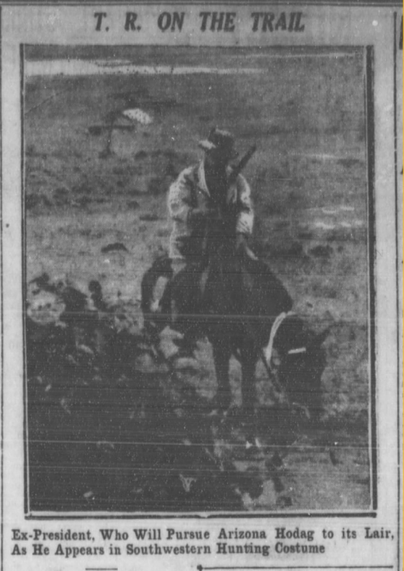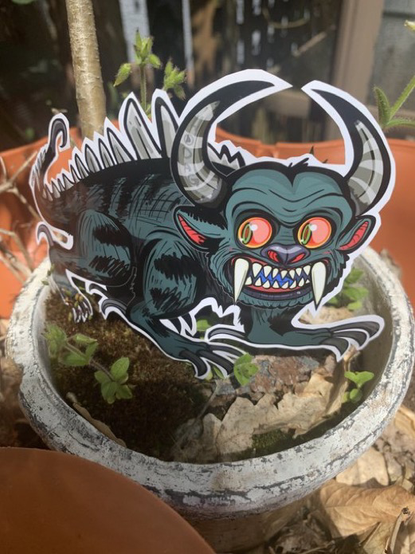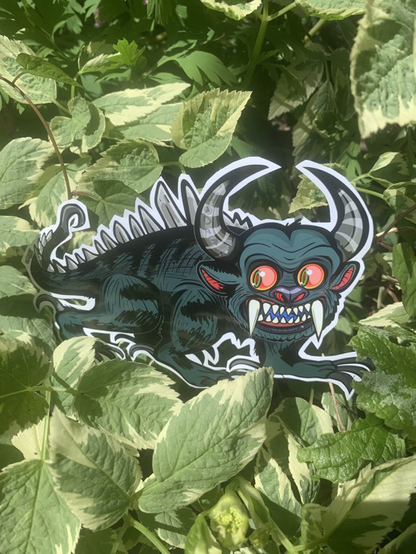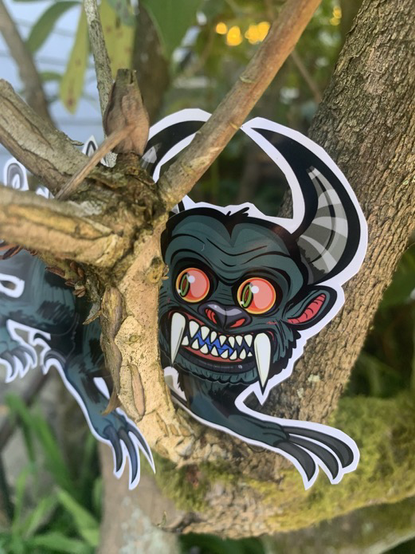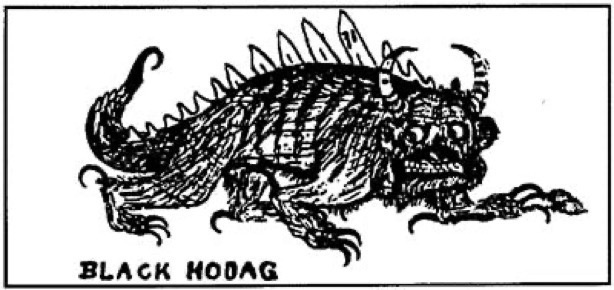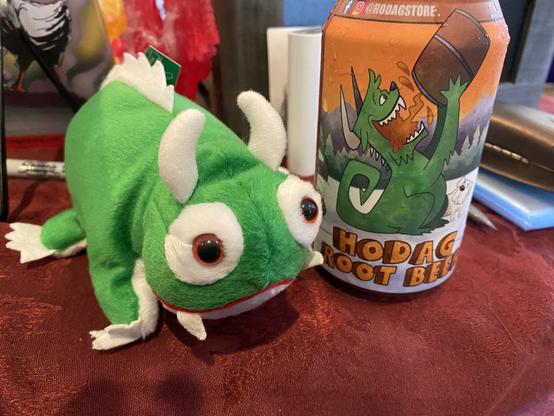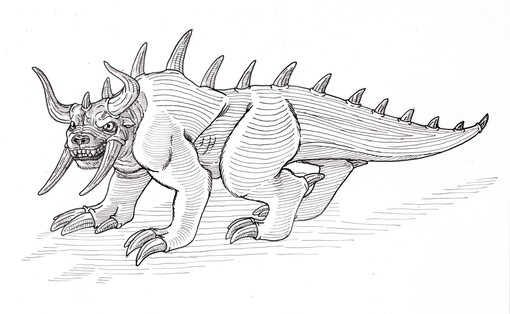The Hodag, a mythical creature from northern Wisconsin, has influenced local culture for over a century. Originating from logging camp folklore, it reflects regional anxieties and ties to the past. #hodag #cryptids https://connectparanormal.net/2025/04/11/the-hodag-wisconsins-legendary-forest-creature/
#hodag
The premise of Pop Goes the Cryptid is that the view of doubtful animals (cryptids) has shifted from being a potentially scientific effort of zoological discovery called “cryptozoology” to that of being a media-driven, cultural and commercialized pop culture phenomenon. It doesn’t mean that there aren’t still efforts to find hidden mystery creatures but, more often, the cryptid has a more “folk” importance. An excellent example of a pop cryptid, and one that is currently exploding in popularity, is the Hodag, the mascot of Rhinelander, Wisconsin.
Modernly depicted as a stocky, aggressive, green-black, feline-frog-dinosaur mash-up with red eyes, huge claws, a spiny-ridged back, and fearsome saber-teeth, the Hodag’s origin is obscure. Existing historically, and orally, as a tale of lumberjack folklore in the northwoods, the Hodag legend was reimagined, and solidified, by storyteller and jokester Gene Shepard in the closing decade of the 1800s. Shepard brought various pieces together from tall tales and Ojibwa legends, and, using wood, ox hide, and some accomplices, created a wondrous piece of fakelore.
The ancestor of the Hodag is considered to be Mishipeshu, the spirit creature of the native tribes of the Great Lakes area and northwoods. This “great lynx” was depicted as powerful, and dangerous, with a spiky back and tail, and it lived in the deepest parts of lakes and rivers. Mishipeshu is commonly referred to as the water panther. Some historians believe that the mishipeshu figure had a part to play in the Hodag heritage that Shepard (who spoke Ojibwa) used to bring the modern Hodag legend to life.
Mishipeshu pictograph on Agawa Rock at Lake Superior Provincial Park, Ontario, Canada.In William Cox’s Fearsome Creatures of the Lumberwoods (1910) (see the 100th Anniversary hypertext edition), the Hodag’s appearance is ridiculous, giving us ample foundation to conclude this creature was a made-up story from the Wisconsin and Minnesota lumber camps. Cox notes that it was reportedly rhinoceros-like, hairless and intelligent, and that its body color may be plaid, like the lumberjack coat. Its nose has a spade-shaped horn that grows in an outward direction, blocking the creature’s line of vision so that it can only look up. It searches for porcupines in the trees. When it finds one, it digs around the host tree (with its shovel-nose) so that it falls over, dislodging the porcupine, which is then eaten by the Hodag. For the winter, the Hodag covers itself in pine pitch, rolls in the leaves, and stays warm.
Depiction of Hodag by Cox’s illustrator Coert DuBoisOther legends also indicate the Hodag was some 7 feet long and the reincarnated spirit of the study oxen that dragged logs from the forest (and thus “scientifically named Bovine spiritualis). Early tales never indicated it was a genuine zoological animal. However, it’s not inconceivable that its aggressive nature might have been influenced by the wolverine – which was killed off in those parts by around the 1870s.
From Philadelphia Inquirer, 1897While the tale was known prior to 1893, Eugene Shepard, from Rhinelander, crafted the mythical Hodag into a creature for his own greater purposes. He claimed to have found one in 1893 in the swamplands. He wrote for the local newspaper detailing his account and it was a hit.
In 1895, he created a model out of wood and real animal parts, staging a photo with local men playing along to depict its capture. This is the Hodag we know and love.
In 1896, he staged a side-show “display” of the creature for the Oneida fair and then traveled with it. There was no real animal in the display, but that was not the point – it was the great story that people wanted to see and hear. Check out these pieces to learn about Shepard’s creation and how he was like the P.T. Barnum of Rhinelander.
The Hodag: How Fakelore Became Real | Flyover Culture
https://www.youtube.com/watch?v=6zprRsGgLEo
Hodag: The Fearsome Creature Roaming American Wilderness – Real History channel
https://www.youtube.com/watch?v=LpkMlzJxgfs
The Hodag now had a specific form and was known to be very dangerous and stinky, but it wasn’t only the creature that smelled funny. The newspapers spreading Shepard’s story sometimes led readers outside the Northwoods to believe that outrageous animal tales like this were true. Some people may have thought the Hodag was real. Shepard continued the ruse by leaving his motives unclear. He suggested that he had really found a Hodag but let it go and said it was a hoax in order to protect it.
What a great logo for the local high school team!But for Rhinelander, Wisconsin residents, it was no hoax. It is an important part of their heritage. They adopted the Hodag as the town mascot in 1918. Even though there was a dispute in the town about how much to embrace the “fakelore” Hodag, ultimately, the creature won the hearts of the town. As sometimes happens, the “fakelore” was widely accepted and morphed into real folklore. As UW-Madison folklore professor Lowell Brower noted (in the Flyover Culture video above), the Hodag created by Shepard was “folkloresque” – based on folklore and drew its power from that. Rhinelander “lovingly appropriated and commercialized” the legend. It appears everywhere in the town and draws visitors that would otherwise never look twice at the small town in Northern Wisconsin.
Today’s Hodag is based on Shepard’s tale, not the lumberjack tale memorialized in Cox’s 1910 volume. In some depictions, the Hodag now resembles the original Chupacabra (spiky back, red eyes, sharp teeth and claws, and a lizard tongue). The ambiguity of the hodag invites participation, and people are happy to act out the legend (called “ostention) by pretending it’s real and even hunting for the creature. The fact that the Hodag was a known hoax did not stop people from wanting to see it.
The latest claims to fame for the Hodag is its appearance in a 2012 Scooby-Doo episode, where “Gene Shepard” appears as a showman with a traveling cabinet of curiosities.
The Hodag also has an entry in the Harry Potter universe book Fantastic Beasts and Where to Find Them where their horns were said to have magical properties to keep people awake for days and be unaffected by alcohol.
You can find lots of Hodags in the Hodag store in Rhinelander, where the owner Ben Brunell says the symbol brings the community together. He opened the store because people wanted Hodag souvenirs. A traveling Hodag exhibit appeared at the 2024 Mothman festival and at many other places across the US. And you can stay at the Hodag AirBnB which is also crawling with the creatures. So while the legend of the Hodag is flourishing, a real flesh and blood creature will, by its non-nature, be impossible to find.
Bibliography and More:
- The Rhinelander Visitors Page – https://explorerhinelander.com/
- The Rhinelander Chamber of Commerce – About the Hodag https://www.rhinelanderchamber.com/about-the-hodag/
- Wisconsin Historical Society – The Hodag: Learn the history of the Hodag, Rhinelander’s mystical menace https://wisconsinhistory.org/Records/Article/CS16353
- Pioneer Park Historical Complex https://rhinelanderpphc.com/hodags/
https://moderncryptozoology.wordpress.com/2024/10/10/hodag-wisconsins-homegrown-and-beloved-monster/
#cryptid #Cryptozoology #GeneShepard #Hodag #lumberjackTales #mascot #Mishipeshu #monster #Ojibwe #PopCryptid #Rhinelander #tallTales #Wisconsin
Hodag!
"I smell a Hoe Dagg!... gonna track it down"
More than 3 are a "pack of hodags".
Used in a sentence:
"I saw a pack of hodags workin' the corner of Fifth and Lincoln last night."
Pop cryptid chatter: Beards and encryptids
My favorite fringe topic has always been cryptozoology, which is the intersection of animals and mysterious weirdness. As I’ve written about the subject of “pop cryptids”, fabulous monsters are now mainstream. They have become ubiquitous online and in American culture, not so much as possibly real zoological organisms to be scientifically recognized (because none have been) but as symbols, icons, and genii locorum (spirits of a place). It’s my opinion that these current depictions of cryptids are where the fascinating content lies, and that there is little value in considering cryptozoology as a zoological endeavor. The reasoning is complex but that leaves so much left to explore for these cultural concepts. For this post, I’m sharing some pop cryptid related items I found this week.
For more on Pop Cryptids, head to Pop Goes the Cryptid or see other posts here.
Cryptozoologists, represent!
Did you ever notice something in common between featured speakers of cryptid conferences?
What is with the beards?! Yep. Every one of these are guys with beards. (Hats may be an indicator of which of them are less “academic” and more field-oriented.) You may recognize a few of these usual suspects.
It’s all too easy to apply these generalized characteristics to those interested in particular fringe topics. (Maybe it’s just me, because I’m not a beard-fan.) And, I will admit, it’s not totally fair. That is, the audience is more diverse. The photo above was from the 2023 Florida Bigfoot event in which a YouTube video of the vendor room showed, Ok, many more beards, but also many women and some kids. Regardless of the audience, the narrow demographic appearing on the stage representing the leadership in this community is glaring. The invited speakers are not scientists (except for usually one who flashes that label for cred – last year J. Meldrum and this year R. Holland). The story, not the science, is the star. To me, that says something important.
The 2024 event just took place last weekend and not much has changed. The generalization holds.
Additional photos show that the appeal of the idea of Sasquatch, and all the cute and kitschy stuff related to it, is embraced by the younger generation because it’s fun. Not so much because they really think it’s a legit undiscovered animal.
From the NPR affiliate in Florida:
[Organizer] Pippin estimated that more than 2,000 people in total visited the conference, which featured a stage for speakers and about 45 vendors.
Ryan “RPG” Golembeske, 48, served as master of ceremonies.
“You are in the one absolute safe place to go all in on the squatch,” Golembeske said to the crowd. “Everybody here wants to talk about it. Everybody here is obsessed with it.”
I don’t think it’s healthy to be obsessed with an unproven creature. But, that’s a word that’s maybe overused these days. Maybe not.
And cryptid proponents love to tout how youngsters are getting into the cryptozoology act and often give them a platform. However, I’ve seen many such teens grow out of belief in forest monsters as real life dawns on them. Some stay hooked all their lives. Since we have 50+ years of actively looking for Bigfoot and not finding it, this seems like a highly questionable obsession.
The Encryptids
This week saw the Electronic Frontier Foundation launch their membership drive featuring The Encryptids – “the rarely-seen enigmas who inspire campfire lore. But this time, they’re spilling secrets about how they survive this ever-digital world.”
It doesn’t take a genius to figure out that cryptid creatures can be creatively used for cryptocurrency and encryption. This promotional material is charming.
Note the appealing “cute” factor – a key to reaching a wide audience. It also appears EFF will be loose with the cryptid label by featuring not just Bigfoot, but a Jackalope and maybe a ghost. I do like it, though. Why not? It’s a good cause.
For your listening pleasure
Besides the Jackalope, a famous manufactured animal of renown is the Hodag, the official mascot of Rhinelander, Wisconsin. I want to recommend the Urban Legends podcast episode on the Hodag written and hosted by Luke Mordue.
Check it out here. And have a listen to the other Modern Myths episodes.
Passing of Richard Ellis
Finally, I was sorry to hear of the passing of Richard Ellis, 86, an author and artist who greatly informed me about marine life. His Monsters and the Sea is one of my top cryptozoology books.
I recommend his NYT obituary and this tribute by Darren Naish on Tet Zoo.
It is a sign of a life well-lived when you leave behind your lauded words, images, and ideas to continue on.
#animals #Bigfoot #cryptids #cryptozoologist #Cryptozoology #encryptids #Hodag #Internet #Monsters #podcast #popCryptids #popularCulture #RichardEllis #Sasquatch
https://sharonahill.com/?p=8596
Location and imagination equals ‘cryptid’
Today, I’m making some general observations on the subject of strange animal sightings. I recently visited Lake Champlain and am convinced that many sightings of Champ, the lake monster, were logs or other mundane objects or animals. There are no cryptids there. But there is a granite marker and a friendly-looking fiberglass Champ depiction at Perkins Pier in Burlington, Vermont. Champ is stylized as a huge dragon-like sea serpent. It’s a mascot of the lake and the local baseball team. I can’t help but love this, while at the same time be frustrated by the remaining trend to suggest Champ is a prehistoric reptile or rare animal. The legend is sustained by the location and people’s sense of imagination.
Champ as the mascot of the Vermont Lake Monsters baseball team, Burlington, VermontStrange animal stories have always had, primarily, a theme of wonder and amazement. Even when the animal is clearly visible, such as with clear videos or carcasses, many spectators opinionate that the creature is a “mutant” or a new species. They don’t recognize the obvious, natural, and better explanations. Or, they refuse to accept them because it is more fun to speculate.
Could our need for fantasy creatures be contributing to cryptozoology failing as a scientific field?
The area of study that was called cryptozoology gained scientific credibility with a society and a journal established in 1982. A group of scientists and people interested in animal research founded the International Society of Cryptozoology. Its mission was to investigate and analyze reports of unexpected animals with the goal of determining if they were new species that could be cataloged and scientifically known.
That didn’t work out well. The society dissolved in 1996 with no clear successes other than to document the optimistic nature of the participants. The scientific credibility declined, but some zoological hope still lingers, as several followers of the field insist that it can be a legitimate means of discovering new animals. The prospects for this goal grow weaker every year. Instead, the popular mythical and romantic view of cryptozoology has swamped the idea of cryptozoology as a scientific endeavor. The cryptid legends seem ever more immune to scientific thinking. The skin and blood of cryptids are made of human imagination and the spirit of place.
The Hodag of Rhinelander, WisconsinIn the 2000s, there was still a strong tone of cryptozoology as a science-based endeavor. But, by then, it was almost entirely the domain of amateurs. Unlike fruitful areas of scientific investigation, the evidence never got better – there were no bodies, no DNA, no tested theories, just better hoaxes and more media circulating with enthusiastic commentary.
There also was more attention to local promotion. Festivals associated with local creatures became popular. Public displays became more prominent. New social media featuring existing legends, and creating entirely new ones, expanded the reach of cryptids to the younger online generation. This promotion, done on TV, YouTube and TikTok was done by non-scientists, even teens who knew little about the origins of cryptozoology.
A Bigfoot mascot in Whitehall, New York (at the Southern reaches of Lake Champlain)Many cryptids are almost always associated with particular locations. The obvious are lake monsters because they are bounded by the water. (Almost every large lake has a story of a monster.) This is reasonable, as the legend is rooted in and grows around a cluster of reports. Land animals are naturally attributed to an area, like a forest or swamp. Here are some examples:
- Dogman – Forests of Wisconsin and Michigan
- Mothman – West Virginia and later Chicago area
- Bigfoot – Typically tied to the PNW but by the 1970s became popular in many states, often referred to by a local name [Beast of Boggy Creek (Arkansas), Momo (Missouri), Skunk Ape (Florida)]. Certain areas were associated with ape-like beings and other paranormal concepts and entities – Chestnut Ridge (Pennsylvania), the Appalachians, and Skinwalker Ranch (Utah).
- Ultra local stories include Loveland Frog, Dover Demon, Beast of Bray Road, Lizard Man of Scape Ore swamp, Goatman.
Of course, there are exceptions:
- Chupacabra – Started as a Hispanic legend and became a catch-all term for any weird animal anywhere.
- Yeti – Began as associated with the Himalayas but became iconic worldwide even though still connected to its origins in cold, mountainous regions.
- Entities that may be considered “fantasy creatures” like merfolk and fairies (and related beings) show up everywhere people have brought their culture and stories with them. The same can be said for Bigfoot (wild man) and lake monsters.
Cryptids tied to locations seems to be a product of the environment + promotion. The legend will often readily morph into a mascot for a town or area. The locals may eventually embrace their monster and make the most of it. The commodification and exploitation of the cryptid aids in the drift away from the prospect of a serious scientific endeavor to find it. It also promotes fakery for attention or fun.
The Comegato
The latest invented cryptid is the Comegato of Maine, a weasel man creature featured in a “documentary” on YouTube. While I’m sticking to the U.S. in this post, see also the British Cryptid (1974) YouTube channel for invented local cryptids.
As the depiction of cryptids turns more towards entertainment and whimsy, the thought of the “-ology” part becomes less emphasized. Many people will admit they don’t want their local creature found or identified. They love the mystery and will actively seek to preserve it. Thus, the cryptids’ value lies not in zoological discovery, but in social needs. The field of cryptozoology may be doomed to further slide towards a fictionalized, pretend idea of science.
There is nothing wrong with celebrating your local legends. I think the depictions of Champ, Bigfoot, the Fresno Nightcrawler, the Hodag, and all the other crazy critters are awesome, and I want to see the statues and swag. Celebrate your local monster for all the human reasons it exists.
#Bigfoot #ChampLakeMonster #Comegato #cryptid #Cryptozoology #Hodag #lakeMonsters #Monsters #Paranormal
https://sharonahill.com/?p=8584
I borrowed https://www.goodreads.com/en/book/show/59978434-the-united-states-of-cryptids book at the library and have been drawing most (I skip the bigfoots/monkeys/boring ones) of the cryptids as I read.
These are the midwest ones
Cave Hodags - [fearsome critters] - a subterranean variant to the 'Sidehill-Dodge-Hodag' & its evolutionary successor. They have 3 glowing eyes & 5 legs for scaling walls, The Wisconsin Speleological Society has held 'Cave Hodag Hunts' since 1965! - : Full post: https://samkalensky.com/products/cave-hodags
Hoedag - [Fearsome Critter.] - The 'Lake Monster. of St Marys, Ohio.' It has a long neck with an eerie glowing green eye on its forehead, a bright red eye on its tail & round plate-like feet. Said to steal Pumpkin Pies & eat lost little dogs...🚦Full post:
https://samkalensky.com/products/hoedag
#hodag #hoedag #lakestmaries #folklore #fearsomecritter #cryptid #mastoart
In todays full #hodag post I covered a lot of lesser known/talked about hodag variants! ( including one hunted by teddy rosevelt in 1913! ) https://patreon.com/samkalensky
The Hodag. - [Fearsome Critter] - Vicariously described among lumbermen & most famously attributed to Rhinelander Wisconsin. - "Hodags" are usually noted for their ugliness, ferocity & stench. Whenever an Ox is cremated in the woods, a hodag is born... 🍋 Full post: https://samkalensky.com/products/hodag
#cryptids #folklore #rhinelander #hodag #rosevelt #mythology #MastoArt
Whotcher, Hodags!
#Iowa's Whatcheeria deltae sounds suspiciously like #Wisconsin's #Hodag. You never see them in the same place at the same time, right?
My artistic interpretation of the Hodag attached for comparison, along with the W Deltae from
https://academic.oup.com/zoolinnean/article/193/2/700/6144098
https://www.joviko.net/hodag.html
https://www.atlasobscura.com/articles/whatcheeria-iowa-predator
Whotcher, Hodags!
#Iowa's Whatcheeria deltae sounds suspiciously like #Wisconsin's #Hodag. You never see them in the same place at the same time, right?
My artistic interpretation of the Hodag attached for comparison, along with the W Deltae from
https://academic.oup.com/zoolinnean/article/193/2/700/6144098
https://www.joviko.net/hodag.html
https://www.atlasobscura.com/articles/whatcheeria-iowa-predator
We believe that investing in people is better than investing in cryptocurrency. Help us make a difference for college-bound high school seniors in Wisconsin’s Northwoods by making your donation to the Clambake Society Scholarship today!
#Hodag from Rhinelander, Wisconsin
Fearsome Crittober Day 4: The Hodag. #hodag #art #fearsomecritters #folklore #americanfolklore #inktober #inktober2018 #creaturedesign #ink #monster
A monstrous creature native to Wisconsin. Covered in green fur, with red eyes, horns, tusks, large claws, and a back covered in spines, the Hodag is about the size of a large dog.
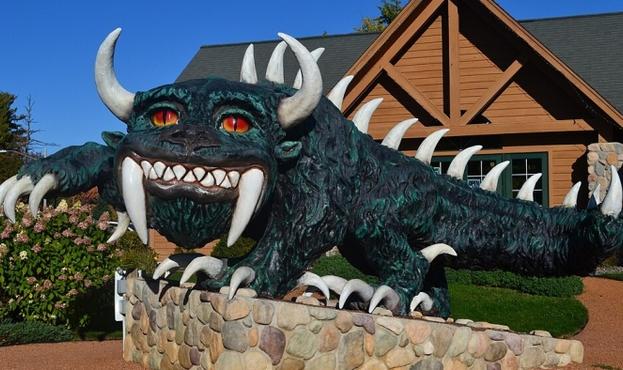

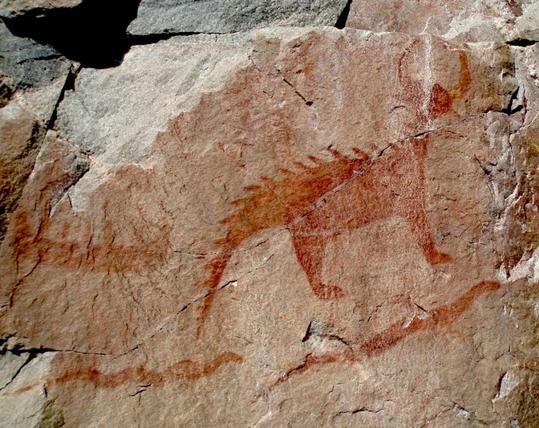
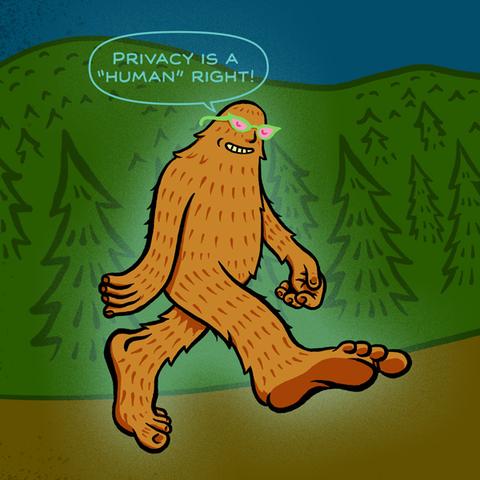

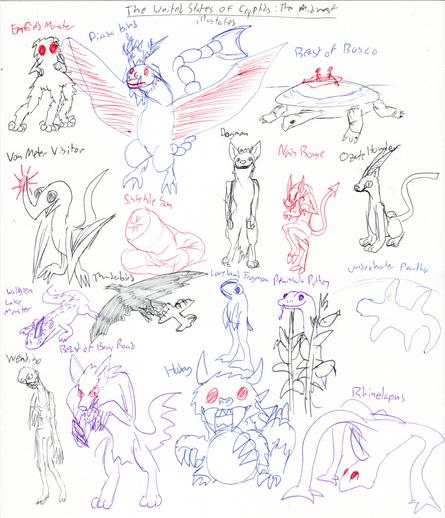

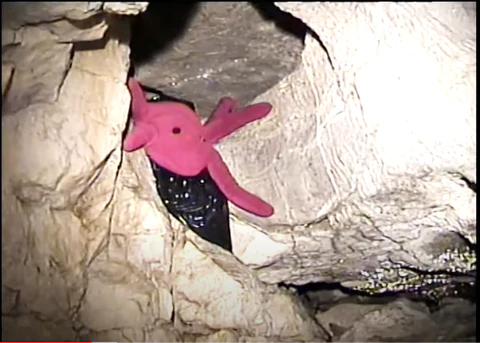
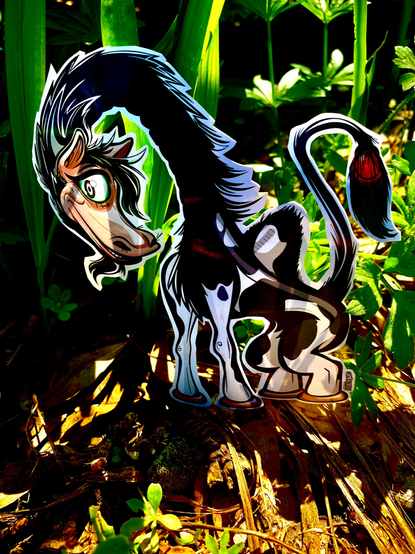
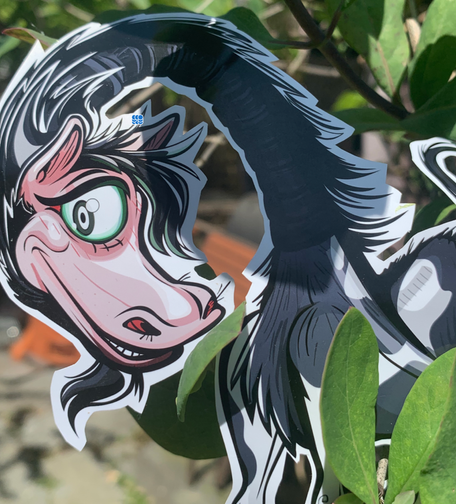
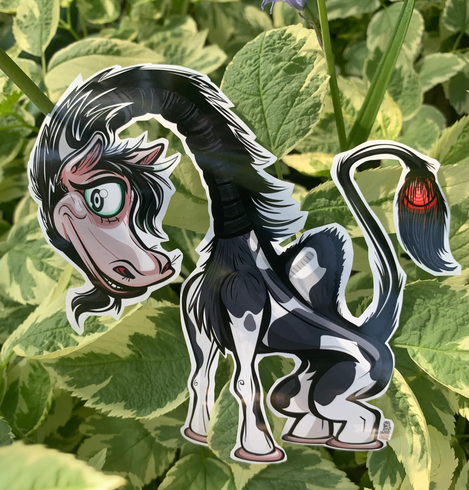
![[Newspaper excerpt of the 'Hoedag' as drawn by "Edward Fusk." - Photo Thanks to the lake improvement association.]](https://files.mastodon.social/cache/media_attachments/files/110/454/496/644/227/278/small/96bdc1d8c12040df.webp)
